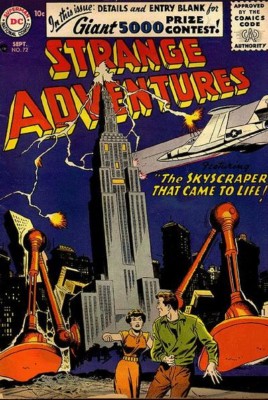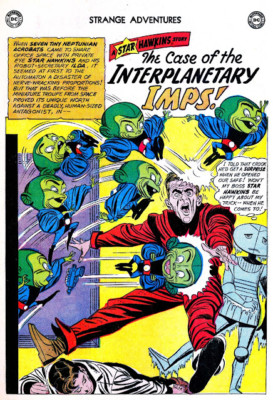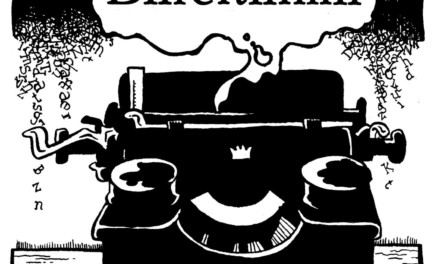 “Space Detective is a truly remarkable work of imagination run riot . . .”
“Space Detective is a truly remarkable work of imagination run riot . . .”
Ron Fortier posted a nice positive review of Space Detective this past weekend on his entertaining Pulp Fiction Reviews blog. His description above is exactly what I was aiming for while writing: to present the reader with something surprising and unexpected.
The back-cover blurb captures the vibe I was chasing in this novel: “The 1950s: Private eyes. Jazz. Juvenile delinquents. Scandalous crime and horror comics. UFO sightings.”
The inspiration for the character, in part, was the 1950s-era private eye as cool-but-hard-boiled man of action portrayed in novels, short stories, TV shows and movies. He was real detective—not just a thug with a gun and set of brass knuckles—who used his smarts, his personality, and the tools of his trade to solve mysteries. And he usually had a nifty soundtrack.
That was the foundation for my character. Thrown into a science fictional world.
But a mystery remains: who—or what—is Space Detective? A few hints are sprinkled through the novel, but nothing definite is ever stated.
I can’t tell you the answer to that question. Not here, anyway. But along with the prose and cinematic private eyes, Space Detective was inspired by some other fictional creations. I can share those:
1950s comics published by National Periodical Publications (known today as DC Comics).
This period has become known as the Atomic Age of Comics, sandwiched between the Golden Age (the birth of the comic birth industry and many competing superheroes) and the Silver Age (the resurgence of superhero comics in the 1960s). During this middle period, a focus on SF and post-war fascination and fear of atomic power was common in DC Comics.
 Strange Adventures and Mystery in Space were two long-running titles that launched in 1950 and 1951, respectively. Both were anthology magazines featuring two or three stand-alone stories each issue with an SF or fantasy slant. What comic-reading kid could resist story titles like these? (Almost every story title ended with an exclamation point—a clear indicator you’d be getting sure-fire exciting entertainment once you handed over your thin dime to the cashier.)
Strange Adventures and Mystery in Space were two long-running titles that launched in 1950 and 1951, respectively. Both were anthology magazines featuring two or three stand-alone stories each issue with an SF or fantasy slant. What comic-reading kid could resist story titles like these? (Almost every story title ended with an exclamation point—a clear indicator you’d be getting sure-fire exciting entertainment once you handed over your thin dime to the cashier.)
- “The Menace of the Green Nebula!”
- “The Atomic Invasion!”
- “Man into Martian!”
- “The Plant that Plotted Murder!”
 Plants weren’t alone in plotting. Gorillas were always up to something in the pages of these magazines. Here are a few examples:
Plants weren’t alone in plotting. Gorillas were always up to something in the pages of these magazines. Here are a few examples:
- “The Gorilla World!”
- “The Gorilla Who Challenged the World!”
- “Gorillas in Space!”
- “The Gorilla Conquest of Earth!”
- “The Amazing Trial of John (Gorilla) Doe!”
- “The Human Pet of Gorilla Land!”
- “Challenge of the Gorilla Genius!”
Okay, that’s enough gorillas. We don’t want to encourage them too much.
Skyscrapers saw some action too, but nowhere near as much as the gorillas: 
- “The Skyscraper that Came to Life!”
- “Secret of the Skyscraper Spaceship!”
Among all these melodramatic one-shot stories, a few series characters appeared as well. Most had an SF slant, and some relied on superhero tropes as well. But nearly all integrate some aspect of mystery solving in their plots, which makes them forefathers to Space Detective.
Space Cabbie – the name says it all. A 22nd Century Ralph Kramden driving fares between the planets, he tells tall tales to his passengers and has a few odd encounters with aliens and doppelgangers. These stories are rather whimsical.
Chris KL-99 – an adventurer in a 21st Century that’s far more technologically advanced than our own, Chris KL-99 looks and feels like pulp magazine hero Captain Future adapted to comics. That makes sense once you know SF pulp fictioneer Edmond Hamilton wrote both series.
Captain Comet – another Captain Future clone, but set in the present day with more of a superhero focus.
 Darwin Jones – this plainclothes SF character first appeared in Strange Adventures # 1. He was a peripatetic science detective for a secret U.S. government agency “called on to solve the unsolvable . . . to explain the inexplicable . . . and to understand the things that few men on this Earth have understood.” A proto-X-Files operative.
Darwin Jones – this plainclothes SF character first appeared in Strange Adventures # 1. He was a peripatetic science detective for a secret U.S. government agency “called on to solve the unsolvable . . . to explain the inexplicable . . . and to understand the things that few men on this Earth have understood.” A proto-X-Files operative.
 Star Hawkins – the first actual SF private eye in this list. Star works the mean streets of 2079 with Ilda, his robot Gal Friday. He’s the usual just-scraping-by type of P.I., and he sometimes has to pawn Ilda to make ends meet until another paying client comes along. Ilda is pretty sharp and solves as many cases as her boss. The stories have a humorous tone, and you can see in this series a spark for the relationship between Space Detective and his never-seen Plutonian pal.
Star Hawkins – the first actual SF private eye in this list. Star works the mean streets of 2079 with Ilda, his robot Gal Friday. He’s the usual just-scraping-by type of P.I., and he sometimes has to pawn Ilda to make ends meet until another paying client comes along. Ilda is pretty sharp and solves as many cases as her boss. The stories have a humorous tone, and you can see in this series a spark for the relationship between Space Detective and his never-seen Plutonian pal.
Space Ranger – this 22nd Century adventurer is part Captain Future, part Lucky Starr (the hero of a series of SF juveniles written by Isaac Asimov)—the hero’s secret identity is Rick Starr. Although Space Ranger has no superpowers, his tales blend P.I. tropes with superhero action. Like typical private eyes of the period, Space Ranger has a secretary/girlfriend, Myra Mason. Like Captain Future, he has an alien sidekick.
Adam Strange – perhaps the most famous character in this list, Strange is a present-day archaeologist inexplicably transported by a Zeta beam from Earth to the planet Rann in the Alpha Centauri star system. There he becomes a hero by battling a variety of threats to the society and solving some mysteries while doing so. Just as each story wraps up and he starts to kiss his beloved, Alanna, the Zeta beam wears off and he’s zapped back to Earth. Fortunately, he has a list of sites and dates for the beam’s upcoming Earth arrivals, so his extrasolar adventures can continue.
Hawkman – this character is typically thought of as a superhero. When introduced in 1961, Katar Hol and his wife, Shayera Hol, were presented as police officers from the planet Thanagar posing as museum curators on Earth. His first published case is to capture a fugitive Thanagarian criminal hiding on Earth.
So there you have it: The SF comic book adventurers and detectives who helped form the character of Space Detective and set the tone for his tale. In a future post, if you’re interested, I’ll explore the non-comic book private investigators who informed the Detective’s creation.


